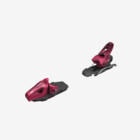2025 Head e-total Joy
The Total Joy offers advanced women a high-performance ski for the entire mountain. A new design lengthens the sidecut, making the Total Joy more forgiving and versatile in a variety of turn shapes. HEAD focuses on managing weight distribution by using carbon in the poplar core, resulting in a lightweight yet strong all-mountain ski. Better Balance technology puts women in an optimum position for easy turn initiation and stability on the slopes.
- LYT Tech Construction
- EMC
- Graphene
- Womens´s Camber
- Superlightweight Distribution
- Carbon Sandwich Cap Construction
- Light Weight Wood Core
- Structured UHM C Base
- Allride Rocker
- Plate: JOY "BB" SLR PRO Base
Intermediate - Advanced
- If you are a seasoned skier learning new skills, or a twice a year veteran taking on new challenges both on and off piste, you will probably fall into this category. Skis for this individual will usually be designed with a stronger wood core and sandwiched-sidewall construction. They will generally also offer both a wider profile and stiffer flex than a beginner - intermediate ski.
All Mountain
- An all mountain ski is engineered to be dependable in most terrains you have in mind. This could include heavy snow, steeps, font-side groomers, ice, and powder. If you have one ski in your quiver, this would be a good choice.
Frontside Skis
- These high-speed carvers will typically have a narrower waist with a full camber profile; maximizing edge grip. Many of them will also have an integrated binding system organic to the ski. If you spend most of your time rocking it on the groomers, these might be right for you.
Rocker/Camber
- A rocker/camber profile keeps camber underfoot, storing and transmitting energy with the rear contact point remaining near the tail. An elongated, early rise, rockered tip moves the forward contact point medially, providing less edge catch and increased flotation in deeper snow.
System Skis with Integrated Bindings
- Skis that include integrated binding systems can be adjusted to most adult boot sole lengths and are compatible with Alpine (ISO 5355) and Gripwalk (ISO 9523) soles. These bindings will not come mounted; always have a qualified technician inspect your boots and bindings before they install, adjust, and function test your system.
- The DIN (Deutsches Institut für Normung) scale on your bindings is the ski industries’ adjustment range for the release force settings on your skis’ bindings. This number will be determined by your age, weight, height, boot sole length, and your skier type (I, II, or III; not your skier ‘ability’). This setting should always be adjusted by a qualified technician after a visual/tactile inspection and function test.
*If you’re unsure if your boots and bindings are compatible, please have a qualified technician give them a tactile and visual inspection.




